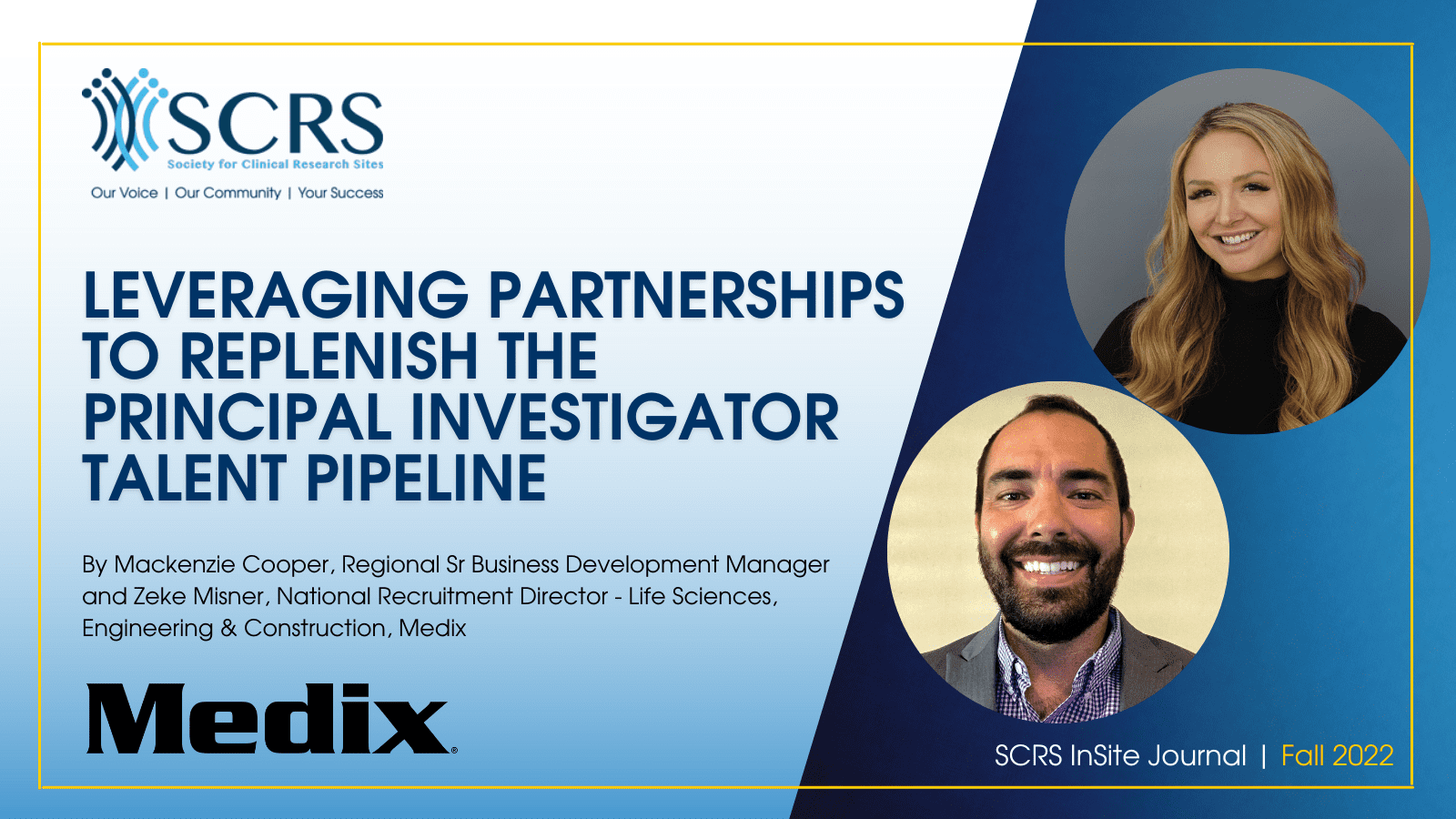Leveraging Partnerships to Replenish the Principal Investigator Talent Pipeline

Perspective from McKenzie Cooper, National Director of Business Development, Clinical Research, Medix and Zeke Misner, National Recruitment Director, Life Sciences, Engineering & Environmental, Medix
There’s no denying the importance of principal investigators (PIs) for clinical research sites. Knowledgeable and experienced site investigators are vital to conducting efficient, high-quality clinical trials. Unfortunately, organizations have historically had a hard time keeping these skilled hires on board. When it comes to a role that is notoriously difficult to keep staffed, sites need to consider leveraging partnerships to ensure a well-stocked pipeline of skilled talent.
The Current State of the Principal Investigator Hiring Pool
Recent research shared by CenterWatch indicates that sites are in the middle of a sea change when it comes to PIs. For the first time in 30 years, the number of novice investigators is declining. Meanwhile, the pool of experienced investigators is growing. While this might seem like encouraging news on the surface, these positive headlines obscure a more troubling story. Overall turnover rates for PIs remain quite high. In fact, the recent growth in retention rates for experienced hires may only be a reaction to the drop in “one-and-done” investigators, spurred on by changes in trial formats in the face of the COVID-19 pandemic.
If that is the case, it highlights a major concern for clinical sites. Will there be enough new PI talent to take on the growing number of research studies? According to National Institutes of Health data, the number of registered studies in the U.S. continues to climb, with 362,500 tallied in 2020, 399,523 in 2021 and, as of the publication of this article, a record 425, 817 studies on the books for 2022. A larger pool of PIs ready to take on this workload will be essential if clinical sites have any hopes of keeping pace with this growth.
The Value of Partnerships
The demand from pharmaceutical, biopharmaceutical and medical device companies to drive new products and generate revenue is straining the site infrastructure across the nation. Sites are being asked to take on more studies but do not have the medical providers on staff needed to do so.
To get there, clinical sites need help. By outsourcing their PI search to workforce solutions and staffing providers, organizations gain a competitive edge in three ways:
- The staffing of medical providers should not be reactionary. Many sites look for MDs/DOs when it is too late, such as after a doctor quits or retires, or when faced with a sudden influx of studies. This is out of necessity. However, a staffing partner has the ability to “respond” proactively, rather than react in the moment. This is achieved by nurturing relationships with doctors, enabling staffing teams to deploy medical providers more quickly as needed.
- Most medical providers use unconventional methods of job hunting. A large portion of medical providers today do not use traditional job platforms, such as job sites. Therefore, sites need a partner capable of opening conversations with PIs in less conventional job offer settings. Staffing professionals can spend time identifying and sourcing talent during networking events, conferences and even from competing sites.
- Internal talent acquisition teams are spread too thin. Most sites have talent acquisition teams that focus on a wide variety of openings for the organization; their time is spread out staffing CRCs, data coordinators, site directors and more in addition to PIs. This type of unfocused work does not yield the same results that a more targeted search can.
The Last Word on the Principal Investigator Pipeline
As sites look to the future, it is clear that it will not be enough to simply retain today’s experienced PIs. To meet the challenges of the expanding clinical trial landscape, our industry needs to put a focus on developing the next generation of investigators. As Christina Brennan, Vice President of Clinical Research at Northwell Health noted to ACRP, “Too often, we [keep going] to the same pool of existing PIs, but we have to find ways to bring new PIs in and mentor them so they remain in the industry.”
There is a growing gap between sites and MDs/DOs needed to take on tomorrow’s PI roles. The harsh reality is that sites do not have the resources and bandwidth to both keep pace with trial demand and spend the time needed to reach these potential hires. At the same time, physicians who are spread thin focusing on patient care need to be sold on the value of making the move to the clinical space, a move that – while impactful – can often be a lateral one.
To bridge this gap, sites are increasingly turning to experienced partners who can provide unique access to a largely untapped principal investigator talent pipeline. Learn how Medix can help today.
Note: This article originally appeared in the Fall 2022 edition of SCRS InSite: The Global Journal for Clinical Research Sites.

Work with a Trusted Healthcare & Life Sciences Staffing Partner
Connect with Medix to get the expertise and resources you need to succeed.
